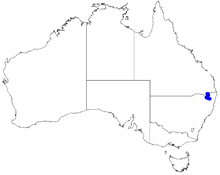Boronia inflexa
Boronia inflexa is a plant in the citrus family Rutaceae and is endemic to tablelands near the New South Wales - Queensland border in Australia. It is an erect, woody shrub with pinnate leaves and up to seven white to pink four-petalled flowers in the leaf axils. Boronia bipinnata is similar but has larger, bipinnate or tripinnate leaves and smaller sepals and petals.
| Boronia inflexa | |
|---|---|
| Scientific classification | |
| Kingdom: | Plantae |
| Clade: | Tracheophytes |
| Clade: | Angiosperms |
| Clade: | Eudicots |
| Clade: | Rosids |
| Order: | Sapindales |
| Family: | Rutaceae |
| Genus: | Boronia |
| Species: | B. inflexa |
| Binomial name | |
| Boronia inflexa Duretto[1] | |
 | |
| Occurrence data from Australasian Virtual Herbarium | |
Description
Boronia inflexa is an erect, woody shrub that grows to a height of about 2 m (7 ft) and a width of about 3 m (10 ft). The leaves are pinnate, 6–25 mm (0.2–1 in) long and 6–35 mm (0.2–1 in) wide in outline on a petiole 3–10 mm (0.1–0.4 in) long. The end leaflet is linear, 1–16 mm (0.04–0.6 in) long and 0.5–2.5 mm (0.02–0.1 in) wide, the side leaflets similar or longer. Up to three, sometimes up to seven white to pink flowers are arranged on a stalk 0.5–9 mm (0.020–0.35 in) long. The four sepals are triangular, mostly glabrous, 1.5–3 mm (0.059–0.12 in) long and 1–2 mm (0.039–0.079 in) wide. The four petals are 2.5–7.5 mm (0.098–0.30 in) long, sometimes with a few hairs. The eight stamens are hairy and the stigma is about the same width as the style. Flowering occurs from June to December and the fruit are 3–3.5 mm (0.12–0.14 in) long and 1–2 mm (0.039–0.079 in) wide.[2][3][4]
Taxonomy and naming
Boronia inflexa was first formally described in 2003 by Marco F. Duretto and the description was published in the journal Muelleria from a specimen collected in the Girraween National Park.[5] The specific epithet (inflexa) is a Latin word referring to the edges of the sepals, near their tip.[2]
In the same paper, Duretto described four new subspecies:[2]
- Boronia inflexa subsp. inflexa that has its branches and leaves covered with minute, soft hairs, and petals 2–3.5 mm (0.079–0.14 in) long;[6]
- Boronia inflexa subsp. montiazura that is glabrous with the end leaflet 3–7 mm (0.12–0.28 in) long and 0.5–1 mm (0.020–0.039 in) wide;[7]
- Boronia inflexa subsp. grandiflora that has its branches and leaves covered with minute, soft hairs, and petals 6.5–7 mm (0.26–0.28 in) long;[8]
- Boronia inflexa subsp. torringtonensis that is glabrous with the end leaflet 10–16 mm (0.39–0.63 in) long and 1–1.5 mm (0.039–0.059 in) wide.[9]
Distribution and habitat
This boronia grows in heath, woodland and forest on granite and in soils derived from granite. Subspecies inflexa occurs between Stanthorpe and the Girraween National Park and disjunctly in the Gibraltar Range National Park and subspecies on a small hill near Applethorpe north of Stanthorpe. Subspecies grandiflora occurs near Amiens amd Lyra and subspecies torringtonensis is restricted to the Torrington area in New South Wales.[2][4]
Conservation
Boronia inflexa subsp. montiazura is classed as "least concern" under the Queensland Government Nature Conservation Act 1992.[10]
References
- "Boronia inflexa". Australian Plant Census. Retrieved 22 March 2019.
- Duretto, Marco F. (2003). "Notes on Boronia (Rutaceae) in eastern and northern Australia" (PDF). Muelleria. 17: 40–44. Retrieved 22 March 2019.
- Duretto, Marco F.; Wilson, Paul G.; Ladiges, Pauline Y. "Boronia inflexa". Australian Biological Resources Study, Department of the Environment and Energy, Canberra. Retrieved 22 March 2019.
- Duretto, Marco F. "Boronia inflexa". Royal Botanic Garden Sydney. Retrieved 22 March 2019.
- "Boronia inflexa". APNI. Retrieved 22 March 2019.
- "Boronia inflexa". APNI. Retrieved 22 March 2019.
- "Boronia inflexa subsp. montiazura". APNI. Retrieved 22 March 2019.
- "Boronia inflexa subsp. grandiflora". APNI. Retrieved 22 March 2019.
- "Boronia inflexa subsp. torringtonensis". APNI. Retrieved 22 March 2019.
- "Boronia grimshawii". The State of Queensland Department of Environment and Science. Retrieved 22 March 2019.